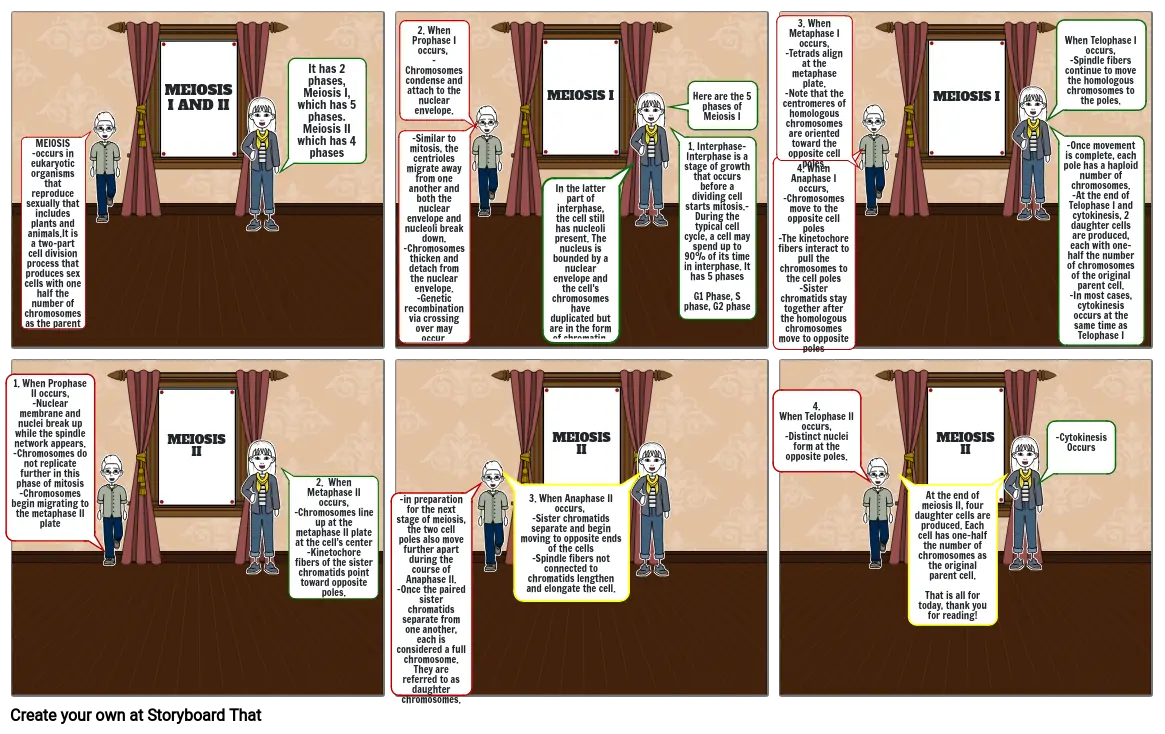Group3_8-Nitrogen_Q2_W6_PerformanceTask3

Texto do Storyboard
- MEIOSIS-occurs in eukaryotic organisms that reproduce sexually that includes plants and animals.It is a two-part cell division process that produces sex cells with one half the number of chromosomes as the parent cell.
- MEIOSIS I AND II
- It has 2 phases, Meiosis I, which has 5 phases. Meiosis II which has 4 phases
- -Similar to mitosis, the centrioles migrate away from one another and both the nuclear envelope and nucleoli break down.-Chromosomes thicken and detach from the nuclear envelope.-Genetic recombination via crossing over may occur.
- 2. When Prophase I occurs, -Chromosomes condense and attach to the nuclear envelope.
- In the latter part of interphase, the cell still has nucleoli present. The nucleus is bounded by a nuclear envelope and the cell's chromosomes have duplicated but are in the form of chromatin.
- MEIOSIS I
- Here are the 5 phases of Meiosis I
- 1. Interphase- Interphase is a stage of growth that occurs before a dividing cell starts mitosis.- During the typical cell cycle, a cell may spend up to 90% of its time in interphase. It has 5 phasesG1 Phase, S phase, G2 phase
- 4. When Anaphase I occurs,-Chromosomes move to the opposite cell poles-The kinetochore fibers interact to pull the chromosomes to the cell poles-Sister chromatids stay together after the homologous chromosomes move to opposite poles
- 3. When Metaphase I occurs,-Tetrads align at the metaphase plate.-Note that the centromeres of homologous chromosomes are oriented toward the opposite cell poles.
- MEIOSIS I
- When Telophase I occurs,-Spindle fibers continue to move the homologous chromosomes to the poles.
- -Once movement is complete, each pole has a haploid number of chromosomes.-At the end of Telophase I and cytokinesis, 2 daughter cells are produced, each with one-half the number of chromosomes of the original parent cell.-In most cases, cytokinesis occurs at the same time as Telophase I
- 1. When Prophase II occurs,-Nuclear membrane and nuclei break up while the spindle network appears.-Chromosomes do not replicate further in this phase of mitosis-Chromosomes begin migrating to the metaphase II plate
- MEIOSIS II
- 2. When Metaphase II occurs,-Chromosomes line up at the metaphase II plate at the cell’s center-Kinetochore fibers of the sister chromatids point toward opposite poles.
- -in preparation for the next stage of meiosis, the two cell poles also move further apart during the course of Anaphase II.-Once the paired sister chromatids separate from one another, each is considered a full chromosome. They are referred to as daughter chromosomes.
- 3. When Anaphase II occurs, -Sister chromatids separate and begin moving to opposite ends of the cells-Spindle fibers not connected to chromatids lengthen and elongate the cell.
- MEIOSIS II
- 4.When Telophase II occurs,-Distinct nuclei form at the opposite poles.
- At the end of meiosis II, four daughter cells are produced. Each cell has one-half the number of chromosomes as the original parent cell.That is all for today, thank you for reading!
- MEIOSIS II
- -Cytokinesis Occurs
Mais de 30 milhões de storyboards criados

